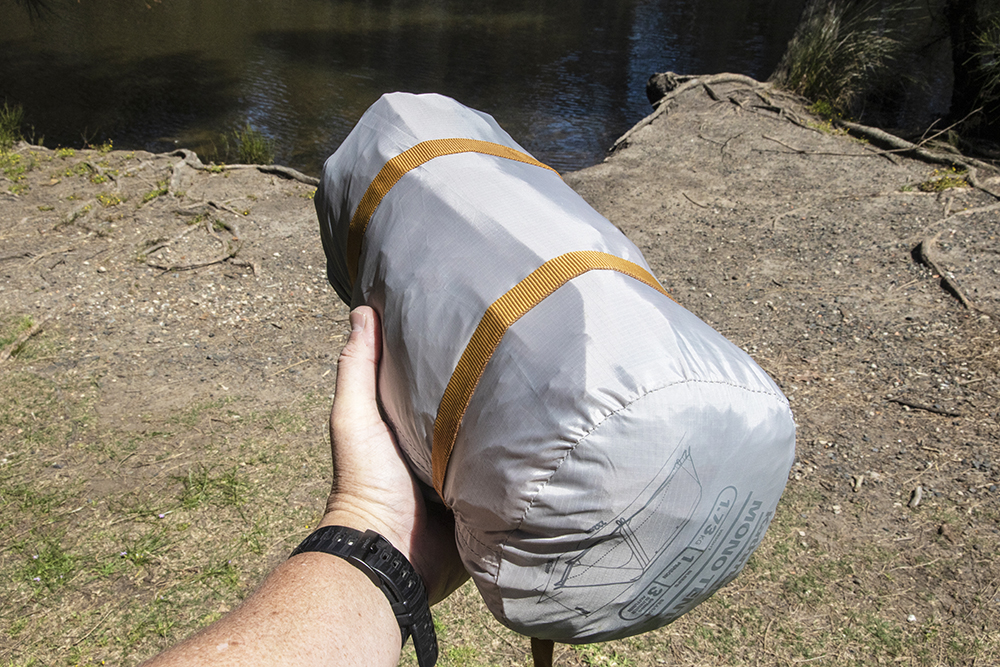Tested: Kathmandu Mono Tent v2

Kathmandu’s three-season Mono Tent v2 is pretty close to that light and tough mark; there are lighter solo tents (the Mono weighs 1.73kg fully pitched) but there are few that match it for a robust build, or the amount of space it offers – always something I look for at a touch over 182cm in height.
The Mono is surprisingly spacious, with a floor area of 1.9 square metres (thanks to its impressive 2320mm length and 1500mm width), although the internal height does max out at 650mm – still enough to be comfortable, but not enough to sit up in. The ‘robust’ comment is validated by the no-nonsense materials choice for the Mono.
The floor fabric (the part of a tent that cops the most punishment) is 150-denier (D) polyester with a super-impressive waterproof rating of 10,000mm HH (Hydrostatic Head). This measure denotes how tall a column of water the tent fabric can hold before the water leaks through; a HH of 10,000mm is close to the highest you will find, with most tents offering floors of around 5000mm HH or less. The seam-sealed 50D polyester ripstop fly offers a 2000mm HH rating – well within the limits needed for a tent fly (most average around 1500mm). The inner fabric (half solid/half mesh for ventilation) is 40D nylon.

Upping the tough-factor even more are the two 9mm high-tensile alloy poles and the 18 alloy pegs. This thing will withstand some pretty wild conditions. The Mono is what is known as a tunnel type tent, meaning it has to be pegged down under tension to stay up. The positives of tunnel tents are that they are great for windy/wild weather due to their generally lower profile and can be set up to align with the wind direction, thus minimising the chance of its structure being compromised.
It also means it is very quick to set up, starting with the inner tent. The two poles (one is taller/longer than the other) are colour-coded and it’s just a matter of threading each pole through the corresponding colour sleeve (these sleeves also add strength as they support the pole across nearly its entire length), and then you insert the pole ends into the eyelets on the floor. Then you peg down the four corners under tension, as well as the pole eyelets.
The fly is then laid over the inner (make sure you align the fly door with the inner tent door) and then there’s a tiny bit of fiddling as you attach the fly to the pole sleeves via Velcro tabs. From here you just peg the fly down through its bungy loops – again, keeping it evenly tensioned is the trick here as it keeps the tent secure and it also ensures the fly is not touching the inner tent, which can cause the tent to leak. As well, it’s worth pegging down all the guy-lines; tunnel tents work best when bound down tight to the ground and this also aids in stability. It sounds like a big job but, really, it isn’t; during testing it was possible to set the tent up in around five to seven minutes at the most.
The vestibule area is not massive but it is adequate for one occupant’s gear; I like to keep my backpack inside a tent whenever possible as it reduces the chance of it getting damp overnight from dew, and it means anything inside is closer to hand. For a low-profile tent, the Mono was quite adept at coping with condensation; three vents in the fly ensure any wind/air that is present will circulate through. One particularly humid night saw a small amount of moisture on the inside but Kathmandu has treated the inner fabric with a finish that causes moisture droplets to run off down the side, rather than drip on you or your sleeping bag.
The only real negative we found during testing of the Mono was its low ceiling height, which just meant modifying how you move around inside the tent. The long span of unsupported roof material between the two poles also looked like it might be an issue in heavy rain, with the potential for it to sag. However, that never eventuated (we did cop one night of moderate/heavy rainfall during testing) as we’d tensioned the tent down properly; with a tight/flat roof, the rain simply rolled off. For a solo hiker – or bikepacking/cycle touring – the Kathmandu Mono Tent v2 is well worth checking out thanks to its competitive price, decent floor-space, fast setup and – most notably – its robust materials and construction.
RRP: $250 www.kathmandu.com.au

